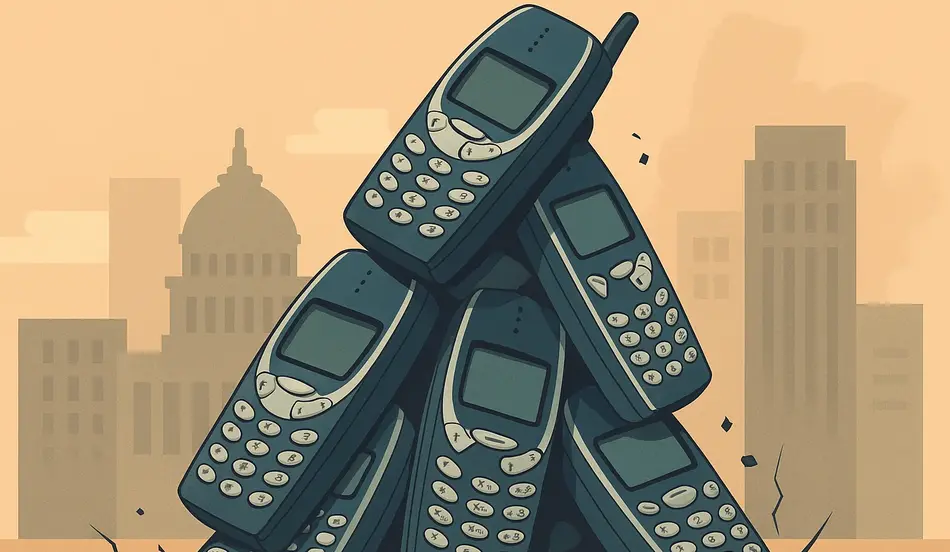The phones were unbreakable… but the empire behind them was falling apart – this is the tragic story of Nokia, the Finnish company that once ruled the mobile world, shaping how billions of people connected, worked, and played. For years, Nokia’s name was synonymous with trust, durability, and innovation, but behind the ringtones, indestructible designs, and iconic models, cracks began to show that would ultimately lead to the company’s dramatic downfall.
Nokia’s story is a masterclass in how even the most successful companies can fail when they fail to adapt to changing markets and technologies. From its humble beginnings as a pulp mill in 1865 to becoming the world’s largest mobile phone manufacturer, and then to its dramatic fall from grace, Nokia’s journey offers valuable lessons for job seekers and business professionals about the importance of innovation, adaptation, and strategic thinking.
From Pulp Mill to Mobile Giant: Nokia’s Unlikely Origins
Nokia’s story begins in an unlikely place – Finland, a country not typically associated with tech innovation. Founded in 1865 as a pulp mill, Nokia spent its early years producing paper, a far cry from the mobile technology that would make it famous. As wars swept across Europe, Nokia adapted by making respirators for military and medical use, demonstrating the company’s ability to pivot and survive in changing circumstances.
The Nokia we know today actually began in 1967, when it merged with two other Finnish companies. This merger allowed the company to start making a host of other products, including rubber boots through its partnership with Finnish Rubber Works. But more importantly, the merger pushed Nokia into the cable and electronics business for the first time.
Before long, Nokia was producing communications gear for the Finnish military, along with mobile radios, telephone switches, and a wide range of electronic components. The company had one big advantage during this era – a trade deal with the Soviet Union, its former enemy. This positioned Nokia as a crucial conduit between East and West during the Cold War, leveraging Finland’s status as a neutral nation.
The Mobile Revolution: Nokia’s Meteoric Rise
As Kari Kairamo took over as CEO in 1977, Finland was gaining a reputation as “Nordic Japan,” and Kairamo wanted to lean into technology. Nokia went on an acquisition blitz during this time, becoming one of the largest television manufacturers in Europe and acquiring the massive German telephone brand Schaub-Lorenz.
Nokia’s most famous product wouldn’t come from the company itself, but from an acquisition. In 1979, Nokia acquired Mobira, and the company soon launched the Mobira Senator – their first car phone. Initially, Nokia had little interest in this business, viewing the mobile phone craze as a passing fad. After all, the phones of that era were clunky, impractical devices that used unpredictable radio signals.
But over time, it became clear that these phones were desirable luxury items – if they could be made sleeker, more reliable, and easier to use. With a change in leadership, everything would be upended. Kairamo died unexpectedly in 1988, and he was replaced by Simo Vuorilehto, who divested from more industrial units and continued to lean into phone production.
The Mobile Revolution: Lessons from Nokia
Nokia’s rise shows how bold leadership and innovation can transform entire industries. Today’s employers can spark their own revolutions by hiring visionaries who see beyond the trends. Post your job on WhatJobs and connect with talent ready to drive the next wave of innovation.
Post a Job Free for 30 Days →The Golden Age: Nokia Dominates the Mobile World
The real transformation came when Jorma Ollila took over in 1992. Ollila had built Nokia’s mobile phone division and convinced Vuorilehto not to sell it when times were tough. Now, as CEO, Ollila was in charge of shaping the company’s future.
The company rolled out its new mobile phone model after the Senator in 1987, and the technology it used would define the new world of communication. The Global System for Mobile Communications – the foundation for the first digital cell phone networks – was built with Nokia playing a central role alongside Germany’s Siemens.
In 1992, Nokia launched the 1011, the first commercial mobile phone designed for this system, and the market responded immediately. After losing money in 1991, the company was earning over a billion dollars in profit by 1995 – and from there, its rise seemed unstoppable.
By 1998, Nokia had surpassed Motorola and produced over 100 million mobile phones. The key to their success? It was all about the kids. This marked the beginning of an era when cell phones became a must-have status symbol for teenagers, representing freedom and the ability to call friends whenever they wanted.
The Nokia 3310: A Legend is Born
The Nokia 3310 was released at the exact right time, coming out at the dawn of the millennium when cell phone use went from being a cult phenomenon to a mainstream thing. This phone would put Nokia on the map and become one of the most iconic devices in mobile history.
The 3310 was incredibly sturdy, coming in one big piece with no fragile plastic to break. It had relatively few entry and exit points, and the buttons were durable. It also had a long battery life, and if powered off, would stay functioning indefinitely. Some models have been found decades later and still turn on when activated.
This durability made Nokia phones legendary, especially among parents who appreciated that their kids couldn’t easily break them. The phones were workmanlike devices with only a few additional features, but they were reliable and built to last.
The Beginning of the End: Smartphones Change Everything
As the 2000s dawned, Nokia struggled to keep up with the big guns. While Nokia was a powerhouse in Europe and around the world, it was still a tiny company compared to electronics giants like Apple, Microsoft, Sony, and AT&T. Once they saw that Nokia’s success in the cell phone world wasn’t a fluke, they wanted in.
Nokia’s share in the cell phone market started to drop. By 2004, it was barely over a quarter of the market, and it would fluctuate through the decade as the market continued to change. The company became known for rolling out new iPhones every few years, creating stampedes to Apple Stores that popped up in malls across the country.
The biggest earthquake came in 2007 when the first iPhone hit the market, changing the cell phone market forever. This phone wasn’t just designed to be a communications device – it was meant to be a computer in your pocket. You could access email, browse websites, listen to music, and make online orders all with the press of a button.
The Fatal Mistakes: Why Nokia Failed
Nokia’s downfall can be traced to several critical mistakes that offer valuable lessons for job seekers and business professionals:
• Slow to adapt to smartphones – Nokia was slow to recognize that the industry was changing
• Stuck with outdated technology – While others developed Android-based systems, Nokia stuck with its trusty old keypad
• Poor strategic decisions – The company tried to adapt with its own Symbian operating system, but it lacked developer support
• Brand positioning failure – Nokia never sold itself as a lifestyle brand like Apple did
• Missed the app revolution – The company failed to recognize the importance of third-party developer support
By the time Nokia recognized that the industry was changing with or without them, it was too late. They were passed not just by Apple, but by other companies like Samsung. The market wasn’t about cell phones anymore – it was about smartphones and the ecosystems that supported them.
The Microsoft Deal: A Desperate Attempt to Survive
In 2013, Microsoft stepped in to save the day, acquiring Nokia’s mobile phone business. While Nokia was a shadow of its former self, it did have one advantage – years of research into strong cell phone infrastructure that a more media-savvy company could take advantage of.
The deal was the end of an era for Nokia and a big blow to supporters of the Finnish company. The chairman at the time, Risto Siilasmaa, acknowledged that this was a difficult decision, but most people believed the company would have crashed if it hadn’t been acquired.
However, the acquisition didn’t turn out to be a win for either side. While Nokia’s technology gave Microsoft a boost, the Windows Phone platform faced many of the same challenges. It lagged far behind Apple, lacked the third-party developer support needed to compete, and struggled to keep pace with the rapid shift toward apps.
The Aftermath: Nokia Today
Today, Nokia is still one of Finland’s largest companies, but it’s much more of a behind-the-scenes powerhouse than it was in the past. The fallout from the company’s merger with Microsoft was devastating – Microsoft lost $7 billion that it wrote down on its taxes, while Nokia lost 90% of its market capitalization.
The company has turned primarily into an equipment supplier, working behind the scenes to ensure smooth production for other companies. Today, the Nokia brand is managed by HMD Global, a Finnish mobile phone company that licenses the name and develops new devices with some input from former Nokia executives.
Nokia owns a 10% stake in HMD Global, providing it a steady financial infusion for little work. But like many companies, its biggest hope might be in nostalgia.
The Nostalgia Factor: A Potential Comeback?
While Nokia made an all-time blunder in the cell phone arms race when it didn’t pivot to smartphones in time, the pendulum might be swinging the other way. Today, we’re seeing an increased wave of concern about what smartphones are doing to attention spans, particularly in children.
Many schools are starting to take action, banning phones bell to bell and making kids go cold turkey. More parents have been holding off on getting their kids smartphones, and that might mean an opening for the return of flip phones and “dumb phones.”
Nokia actually revived its old-school 3310 phone in 2017, geared heavily towards nostalgia. It still had the traditional keypad and one-piece design, although its digital screen was very different and now resembled a smartphone screen’s colorful design. It ran on 3G internet service and was quickly a hit.
Lessons for Job Seekers and Business Professionals
Nokia’s story offers several valuable lessons for anyone navigating today’s rapidly changing job market:
• Adapt or die – The ability to adapt to changing markets and technologies is crucial for survival
• Don’t rest on your laurels – Past success doesn’t guarantee future success
• Stay ahead of trends – Companies that fail to anticipate market changes often find themselves left behind
• Build strong ecosystems – Success often depends on creating and supporting entire ecosystems, not just individual products
• Understand your customers – Nokia failed to understand that customers wanted more than just reliable phones
The key is to remain flexible, stay informed about industry trends, and be willing to pivot when necessary. The companies and professionals who succeed are those who can adapt to change rather than resist it.
Frequently Asked Questions
What does “the phones were unbreakable but the empire behind them was falling apart” mean?
The phones were unbreakable but the empire behind them was falling apart” refers to Nokia’s situation where their durable, reliable phones became legendary while the company itself failed to adapt to the smartphone revolution and lost its market dominance.
How did Nokia rise to become the world’s largest mobile phone manufacturer?
Nokia rose to dominance through strategic acquisitions, early investment in mobile technology, the success of the Nokia 3310, and by capitalizing on the growing demand for mobile phones among teenagers and young adults in the late 1990s and early 2000s.
What were Nokia’s biggest mistakes that led to its downfall?
Nokia’s biggest mistakes included being slow to adapt to smartphones, sticking with outdated keypad technology while others moved to touchscreens, failing to build a strong app ecosystem, and not positioning itself as a lifestyle brand like Apple.
Why did Nokia fail to compete with Apple and Android?
Nokia failed to compete because it was slow to recognize the smartphone revolution, tried to develop its own Symbian operating system instead of adopting Android, lacked third-party developer support, and didn’t understand that customers wanted computers in their pockets, not just phones.
What happened to Nokia after Microsoft acquired its mobile division?
After Microsoft acquired Nokia’s mobile division in 2013, both companies struggled with the Windows Phone platform, Microsoft lost $7 billion, Nokia lost 90% of its market capitalization, and the company pivoted to become primarily an equipment supplier and infrastructure provider.
Is Nokia completely dead today?
No, Nokia is not completely dead – it’s still one of Finland’s largest companies, operates as an equipment supplier, and the Nokia brand is managed by HMD Global, which licenses the name and develops new devices with some input from former Nokia executives.
Could Nokia make a comeback with nostalgia for simpler phones?
There’s potential for a Nokia comeback as concerns about smartphone addiction grow, schools ban phones, and parents seek “dumb phones” for children, with Nokia already reviving the 3310 in 2017 to capitalize on nostalgia for simpler, more durable devices.
A Real-World Example: Maria’s Career Lessons from Nokia’s Story
Maria, a 32-year-old marketing professional, learned valuable career lessons from studying Nokia’s rise and fall. “I was working at a traditional marketing agency when I first heard about Nokia’s story,” she explains. “It really opened my eyes to how quickly industries can change and how important it is to stay ahead of trends.”
Maria had been comfortable in her role, using traditional marketing methods that had worked for years. But after learning about Nokia’s failure to adapt to the smartphone revolution, she realized she needed to update her skills and approach.
“I started learning about digital marketing, social media, and mobile-first strategies,” Maria says. “I realized that if I didn’t adapt, I could end up like Nokia – successful in the past but irrelevant in the future.”
Within two years, Maria had transitioned to a digital marketing role at a tech startup, where she’s now leading mobile marketing initiatives. “The Nokia story taught me that complacency is dangerous,” she explains. “You have to keep learning, keep adapting, and stay ahead of the curve.”
Maria’s story illustrates how Nokia’s failure can serve as a valuable lesson for professionals who want to avoid similar mistakes in their own careers.
Don’t Let Your Career Become the Next Nokia
Nokia’s story is a powerful reminder that success is never guaranteed, and the ability to adapt is crucial for long-term survival. Whether you’re a job seeker, a business professional, or an entrepreneur, the lessons from Nokia’s rise and fall can help you navigate today’s rapidly changing world.
The key is to stay informed about industry trends, be willing to learn new skills, and never become complacent about your current success. The companies and professionals who thrive are those who can anticipate change and adapt accordingly.




